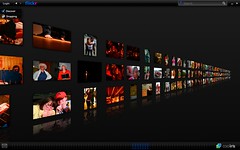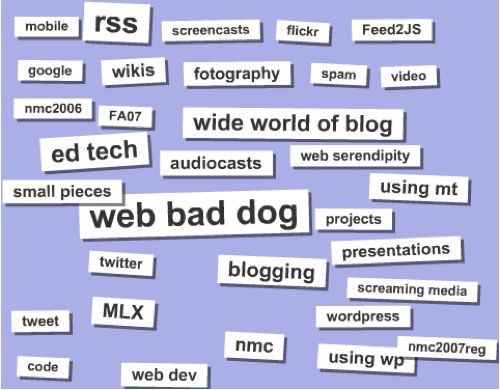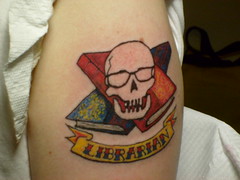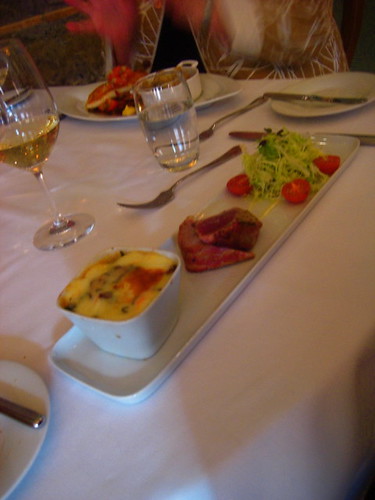This blog post started out as a reference to Alan Levine’s February instructions for tricking CoolIris into a presentation tool — which I wanted to post to a private blog I have for shelving ideas to return to at some point. But I decided to post it here, as the article grew and it’s implications became more apparent. We live and are raising and educating our children in a world where a kid in a garage can dramatically alter an industry. Think about what Sergey Brin and Larry Page did to Yahoo, and how YouTube impacted Google Video. Here, I’m talking about CoolIris, started by three recent Stanford grads, and in less detail, about Prezi, developed by two guys in Budapest, Hungary. Are these Powerpoint killers? I do not know! Probably not. But they indicate a time when geography, age, language, culture, all take a back seat to your ability to observe, think, context, improvise, build, and provoke.
 |
|
|
I’ve seen this done with varying degrees of success, using CoolIris as a presentation tool. I’ve resisted trying it, because I am not that interested in having to upload my slides to Flickr to display them, and I am a vicious slide deck rearranger. However, with CoolIris now accessing files from your iPhoto library, there may be more room for those “morning of” customizations.
Of course I’m speaking from inexperience. Alan Levine (CogDogBlog) referenced in this morning’s report on a New England road tour, a February 7 blog post of his, Tricking out CoolIris as a Presentation Tool. In this post, he talks about a keynote he delivered to the Scottsdale Community College, and his desire to “..delve into two trends (he has a) growing interest in” —
..one being YouTube / video as a communication and its evolving culture. I borrowed heavily from the brilliant videos by Michael Wesch (I am convinced I could make an entire presentation just by playing his videos). And the other the rise of DIY culture and media creativity as a past-time.
Levine continued…
In the back of my mind, I had wondered about the capability of using CoolIris (actually pack when it was PicLens) having just seen its lush 3D wall of images you get when viewing a flickr or facebook page. It is very elegant. And I had noticed they’d added support to explore YouTube in the same interface. I saw that you could use arrow keys to move through images sequentially and said, “One day I will do a presentation in this format”.
Now I would have to actually play with this to determine if CoolIris, indeed, enhances the quality of my presentation, or simply dazzles the audience with the motion. It’s a question I continue to ask myself as I continue to use Prezi. Thusfar, I rationalize it with the shifts it has forced me to make in the planning of my presentations with more focus on the central idea(s). The crowd of people coming up after every presentation, asking about that cool presentation software I was using, is not enough to prove its value — or is it? Shrug!
| You can see Lee & Kim’s two part show on CoolIris here: |
THEN! Scanning through YouTube, I found this apparent TV show with Kim Cavanaugh and Lee Keller — and yes that’s our Dean Shareski he mentions as the source of these techniques they are demonstrating. So I’m immediately thinking, this is a Canadian show, especially as the main speaker sports a ponytail. But then I see the name of the show, Palm Breeze Cafe, and it rings a bell — because those two guys look familar. I look it up, see the full list of show hosts, and there’s my friend Lee Cobert, of —
Yes!
Palm Spring County Schools. But when would they have seen Dean Shareski.
Yes again!
The very same conference I presented at several weeks ago. I just love these kinds of discoveries.
No man is an island,
any more,
ever again!
Anyway, this is just something that I initially wanted to write up for a little private blog I have for archiving resources and ideas I’ll want to come back to — but decided to post it here instead.
Powered by ScribeFire.

 This is one of those cool tools about a cool aspect of the global conversation, tag clouds — from
This is one of those cool tools about a cool aspect of the global conversation, tag clouds — from 












 Bell curve was perfect years ago, because the purpose of school was to sort people out. If we tested ourselves with standard IQ tests and then tested our children, Our children would out perform us by one full standard deviation.
Bell curve was perfect years ago, because the purpose of school was to sort people out. If we tested ourselves with standard IQ tests and then tested our children, Our children would out perform us by one full standard deviation.


 This just in — and causing me some consternation.
This just in — and causing me some consternation.  The keynote speaker will be Robin Harper, former VP at Linden Lab. Other speakers will be
The keynote speaker will be Robin Harper, former VP at Linden Lab. Other speakers will be 

 Zoö Keating makes entrancing, hauntingly beautiful music using a traditional French cello, a MacBook, and an arsenal of audio-crunching software and scripts.
Zoö Keating makes entrancing, hauntingly beautiful music using a traditional French cello, a MacBook, and an arsenal of audio-crunching software and scripts. Added Later, Keating at the San Francisco Airport
Added Later, Keating at the San Francisco Airport